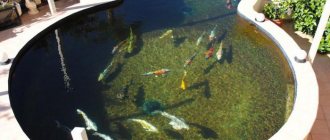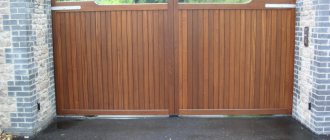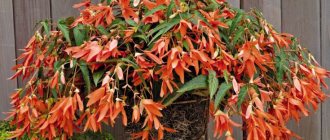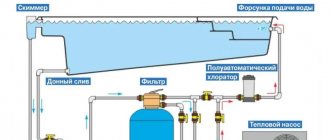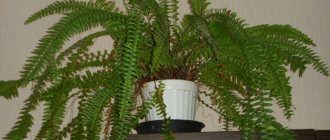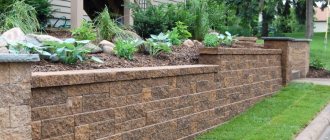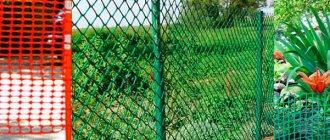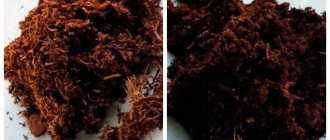Almost every owner of his property wants to make it elegant. A decorative natural pond is the most popular way of arranging a reservoir. It fits well into the landscape, is easy to install, self-cleaning and does not require complex maintenance. If desired, you can add fish to the pond and decorate it with water lilies. A soft design in the form of a pond film will help quickly implement this idea.
Pros of using pond liner
Pond film has a number of advantages compared to other methods of creating a pond:
- forms a reservoir of any shape;
- prevents water from blooming and rotting;
- maintains stable pond boundaries for a long time;
- allows you to save on water consumption by eliminating its seepage;
- does not allow insects and other harmful bacteria to enter the reservoir;
- used on any substrate: soil, concrete, plastic;
- facilitates the care of plants and water resources of the pond;
- allows you to secure movement thanks to the anti-slip coating;
- if it is necessary to reconstruct a reservoir, minimal effort and time are spent.
Purpose of waterproofing material: polyethylene, butyl rubber, “Svetlitsa”
The film is necessary to retain water in the pond and prevent it from being absorbed into the soil of the garden plot. Waterproofing material (butyl rubber, polyethylene, “Svetlitsa”) ensures that the reservoir is not filled with water. The functions are highlighted:
- the ability to give any shape to a summer cottage lake;
- preventing rotting, water blooms, and the entry of microorganisms;
- simplifying pond care;
- the versatility of the film for any base of the reservoir (soil, concrete, stone, plastic).
The waterproofing fabric is environmentally friendly, resistant to chemical influences, mechanical damage, and lasts for several seasons. It can be purchased at a low price. The film does not slip, which ensures safety during cleaning or replacing any decorations.
The preparatory work for waterproofing a pond is not complicated; it can be done by one person, following the instructions:
- A pit is being built.
- It is leveled, the bottom and slopes are compacted.
- The fabric is installed with an overlap.
A pond or artificial reservoir is decorated and filled with water. It is not necessary to invite specialists to lay the film; you can do it yourself.
Types of pond films
PVC film for pond
Cost-effective material for reservoirs and ponds in the country. Suitable for sealing when gluing or welding. Thickness – 1 mm. It can be used for large-scale designs. The warranty on the material reaches 15 years.
Butyl rubber film epdm
Consists of two layers, it is a waterproof material based on synthetic rubber. Thickness – 1 mm, elasticity up to 400 percent. The warranty is about 50 years.
Polyethylene film
It is the cheapest and most fragile material that protects a water structure. It is used at temperatures from minus 60⁰С to 50⁰С. Typically the thickness of such material is 0.5-1 millimeters. It has a high density, without perforation, and has a reinforcing layer. Warranty period is about 3 years.
Decorative film with gravel
PVC based material with a gravel surface laid with waterproof adhesive.
Below we will look at the pros and cons of each option.
Product Description
The main purpose of the film is waterproofing by holding water in its designated place and preventing its penetration into the ground. Compliance with these requirements is a prerequisite for creating an artificial pond.
Film for reservoirs and ponds is a kind of membrane partition that holds water within the required limits.
Types of films
On the modern market there are 2 types of film for waterproofing reservoirs, each of which has its own characteristics:
- Polyvinyl chloride (PVC). According to its main characteristics, it is a high-quality and elastic material for waterproofing. It has a tensile strength of more than 135 kilograms per 1 m 2. Its service life is about 20 years. The disadvantage is that the material is based on vinyl chloride, which is a gas with a large volume of chloride compounds. In their pure form, they are dangerous to human health, but in the form of finished products, the harm of these compounds is minimized. However, you should not breed fish in a pond with PVC waterproofing - chlorine is released from such a film, which will be absorbed by the fish. Long-term exposure to chlorine will negatively affect the inhabitants of the reservoir. This film can be standard, reinforced or reinforced with synthetic polyamides.
- Butyl rubber. Widely used in large ponds and pools, the depth of which is more than one and a half meters. This is a special rubber for special purposes, its composition resembling rubber. Products made from this material are resistant to any natural temperatures; installation can be done at any time of the year. It stretches and contracts well. Service life is about 25 years.
Both materials are practical and have proven themselves. The technology for creating rubber films is based on the polymerization of isobutylene. This gas also contains chloride compounds, but they evaporate to a much lesser extent than in the case of PVC. This determines the relevance of using products of this type for fish ponds. Another good reason for using butyl rubber film is that it has a black color, which allows you to create a bottom with a shade identical to natural.
Specifications
The choice between PVC and butyl rubber should be based on the specific operating conditions of the reservoir. In terms of their chemical composition, they are almost indistinguishable from each other, because they are formed through gases that are relatively inert and do not react. Both materials are chemically passive, making them resistant to various water purification agents and detergents.
PVC film for ponds has the following parameters:
- the weight of 1 m2 is 0.6−0.9 kg;
- thickness - 0.5−1.2 mm;
- high elasticity rates;
- creates an unfavorable environment for viruses and bacteria;
- excellently tolerates low temperatures down to -500 ° C;
- PVC film is resistant to mechanical stress; it can be damaged by an angular metal object or sharp glass;
- not subject to the negative influence of sudden temperature changes;
- waterproofing properties are maintained at pressures up to 2 kPa.
To install PVC film you will need a special waterproof glue. To achieve complete waterproofing, the material must be laid overlapping, the seams are processed with the highest possible quality.
For a pond, it is most advisable to use butyl rubber film, since it has many qualities suitable for this. It is distinguished by the following characteristics:
- weight 1 m 2 - 1.1−1.3 kg;
- thickness - slightly more than 1 mm;
- very high elasticity (much higher than PVC);
- safe for living organisms;
- can be repaired;
- products made from this material do not fade in the sun and do not dry out over time, and cracks do not form on them;
- average resistance to mechanical stress, sharp and hard wood or metal can damage, and the roots of freshwater plants will not damage the integrity of the film;
- there is no need to maintain a special temperature regime, and with sudden temperature changes the geometry of the product changes only slightly (and then only if there is no water);
- withstands pressure up to 2.5 kPa.
Rubber products are more expensive than PVC, but they have clear advantages. One of them is that butyl rubber film can be repaired, and even in case of serious damage with the formation of a large hole, it will be enough to just repair the damaged areas with rubber mastic. Another advantage is that it is produced in rolls 3-25 m wide, allowing seamless connections in large artificial reservoirs.
Installing butyl rubber film is similar to laying out PVC, but differs in that assistants will be needed for such work. This is due to the large dimensions and weight of each roll. One person will not be able to install the coating evenly.
Characteristics of different types of pond films, which one to choose
The most popular pond films are PVC and butyl rubber materials. The first option is cheaper, the second is more expensive, but more durable. Also some
PVC film for pond
Advantages:
- environmentally friendly;
- durable and elastic;
- two membrane layers, high tightness;
- resistant to high temperatures and root systems.
Flaws:
- wet soil;
- will last no more than ten years.
Butyl Rubber Pond Film
Advantages:
- modern material;
- high strength;
- accessible installation;
- resistant to various influences of nature;
- it is possible to partially repair;
- environmentally friendly, does not harm living organisms;
- allows you to apply any finish;
- takes any shape of a body of water and is capable of modification;
- additional equipment ensures, if necessary, compaction of fragments where the equipment is connected;
- durability up to 50 years.
Disadvantages: none.
Polyethylene film
Advantages:
- cheap;
- subject to replacement in case of violations;
- prevents rotting;
- light in weight;
- It is possible to attach during welding.
Flaws:
- does not last long in operation;
- affects the turbidity and blooming of the reservoir.
Decorative film with gravel
Advantages:
- aesthetic appearance of decorative material;
- allows you to create illusionary compositions.
Flaws:
- wet soil;
- will last no more than ten years.
How to build a pond from film with your own hands
Tools and materials for installing a pond at the dacha
Do-it-yourself installation of a natural pond at the dacha is carried out using the following tools:
- level (measuring instrument);
- strong thread for drawing borders;
- wooden supports;
- watering hose;
- shovel.
To build a pond yourself, prepare the materials:
- garden pond film;
- geotextile, concrete to protect the pond from the root system and sharp objects;
- sand for the initial layer;
- well pump with power depending on the size of the reservoir;
- water purifying filter;
- stones for decoration;
- decorative vegetation to decorate a pond.
How to calculate the amount of film and how to choose the location and shape of the pond
To build a film pond, you need to take extra material.
Calculation of a film for a pond: adding the width, length of the planned pond and depth size, multiplied by 2, plus 600 millimeters for stock (allowance).
When choosing a place where the pond will be located, you need to consider:
- The area must be provided with maximum lighting; it is not recommended to plant shrubs and trees nearby.
- It is best to arrange a pond close to water and electrical resources;
- Do not place the pond next to bushes and trees, as their roots can damage the film coating over time;
- The pond should naturally fit into the landscape of the site.
The film of a decorative pond allows you to form and select any shape, as well as size. A pond with rounded lines, without pointed elements, is easy to install, clean, and also looks beautiful.
A water structure is usually equipped with areas for plants.
The depth where fish breeding is planned must be at least 55 centimeters.
Step-by-step installation of pond film, video
A short step-by-step plan for installing a pond with film looks like this:
- Site marking;
- Preparing the pit;
- Compacting the bottom and walls of the future pond;
- Preparation and laying of film on the bottom;
- Laying sand or gravel on film;
- Planting plants (if this is intended);
- Filling with water from a hose;
- Decorating the coastline around the pond (with stones, boulders)
Watch the video for detailed installation of the pond film:
Selection rules
When choosing a film for arranging a pond, you need to take into account not only the decorative features of the material
It is equally important to correctly calculate the waterproofing consumption and take into account some of its operational features
When calculating material consumption, it is necessary to include some reserve. In general, the following formulas should be used:
- film length = pond length + 2 depths + allowances of 30-50 cm on each side;
- film width = reservoir width + 2 depths + allowances of 30-50 cm on each side.
As for performance characteristics, the most important criterion influencing the selection of film thickness is the conditions in which the reservoir will be used. Here the following factors must be taken into account:
- the more uneven and bumpy the bottom is, the thicker the film base should be;
- when the depth of an artificial reservoir is less than 1 m, a film 0.5 mm thick will be sufficient;
- for reservoirs with a depth of 1-2 m, it is better to take the material in a layer of 1 mm;
- for artificial reservoirs with a depth of more than 2 meters, preference should be given to butyl rubber film.
The choice of base material can also be influenced by the complexity of the shape of the garden pond, the presence of elevation changes, and the presence of waterfalls and fountains. In addition, you need to think in advance whether the pond will be used for breeding live fish or swimming.
Manufacturers of materials and price review
The most common manufacturers of pond film:
- The Italian company Agrilac produces PVC roll material with waterproofing properties. These products are among the highest quality and most widely available. The cost varies from 150 rubles per square meter.
- Polish organization IZOFOL , producing waterproofing materials. An important aspect in the production of such film is its quality, which is why it is considered one of the most popular. Price from 250 rubles per square meter.
- The most common among German companies producing waterproofing sheets for ponds is WTB ELBEsecur . Customers are offered a limited choice of PVC material, but this does not affect the production of a very durable product. German film is reliable even under heavy loads. The cost of such material starts from 250 rubles per square meter.
- One of the largest European groups of companies engaged in the production of various components for the garden and vegetable garden is Gardena . The administrative complex is located in Germany. The cost for the material is 170-210 rubles per square meter. They produce very high quality products.
- Another German manufacturer is Heissner . They are engaged in the production of chemical materials and also produce PVC products. It is recommended to choose products from these manufacturers only if there are no other options.
- Models of the elite group use various stones of natural origin in decoration. Regardless of the manufacturer, the cost of the material starts from 750 rubles. per square meter.
When choosing a material, it is necessary to request warranty certificates and service guarantees from a specialized company.
How to glue the film
When arranging a reservoir, you need to take into account its size in order to prepare the appropriate piece of waterproofing material. But if the area or depth of the pond is large enough, then cutting a whole canvas from a roll of film will not work. In this case, several separate parts are prepared, which are connected to each other in various ways.
Important! To prevent the connecting seam on the film from coming apart, its surface is rolled across and then along with a silicone roller. After this, the joint is leveled and treated with sealant.
You can glue the waterproofing film using the following devices:
- double-sided adhesive tape - the joining surfaces are pre-treated with a primer to improve the tightness of the connection;
- mounting adhesive - it contains neopron, therefore it ensures reliable connection of layers of all types of film to each other;
- special adhesive for PVC sheets - it is designed specifically for use in conditions of constant contact with water, therefore it ensures a reliable connection;
- glue-sealant for PVC - before using it, you must thoroughly clean the edges of the joints from dirt;
- welding machine - allows you to reliably connect soft surfaces to each other due to the effect of high temperature on them.
In order to cover the bottom of a reservoir with film yourself, you will need to make some effort and spend a little time. Using the recommendations listed in the article, you can select the most suitable material and correctly fix it in the inside of the pond, obtaining a reliable waterproofing coating that will serve for a long time.
DIY natural pond without film
Without film, alternative options for sealing a reservoir are possible:
- Bentonite mats are one of the types of building materials based on granulated clay located between two layers of synthetic fabric. Upon contact with liquid, the clay layer turns into a gel-like substance. Bentonite strands secure the joint elements. It doesn’t take much time for installation work. Such material can withstand several dehydration revolutions.
- Polyurea spray technology . The material hardens within a few minutes; when used, it can cope with heavy loads. Waterproofing work is carried out by a qualified specialist.
- Spraying liquid rubber is one of the most expensive and modern options. The service life of such material is unlimited. The fabric stretches 450 percent. An environmentally friendly product, resistant to corrosive changes and temperature changes. During installation, you must be able to use modern equipment, as well as have technological knowledge.
- Plastic containers with a volume of up to 50 cubic meters are an expensive material and difficult to install. However, it is not possible for a specialist to install such a pond on the site. The service life is unlimited and does not provide for individual care.
Pond made of plastic mold
For summer residents there are no restrictions in arranging the site. To turn ideas into reality, there are various sealed materials with exceptional technical parameters. All that remains is to choose the most suitable option and decorate the area with a pond.
Decoration with plants
Ideal design - creating a natural picture. Naturalness is the most aesthetic and attractive. They use different plants that live in the depths and grow in the swamp.
- How to make drainage on a site - the secrets of a master on how to make drainage to drain water yourself!
- How to clean a pond: a detailed description of how to clean a pond quickly and easily with your own hands (130 photos + video)
- Decorate the site according to Feng Shui: location features, design elements, Feng Shui zones. How to work with a ba gua diagram? Secrets of garden decoration
Popular articles Pond pump features
They create an expressive landscape, taking into account the number of crops required for a given size. 2-3 types of plants get along well with each other, it’s not worth taking more.



